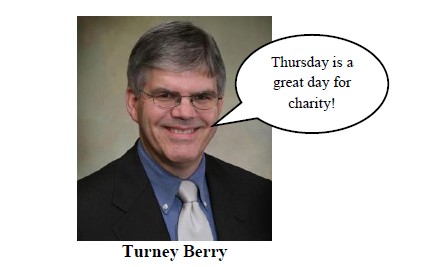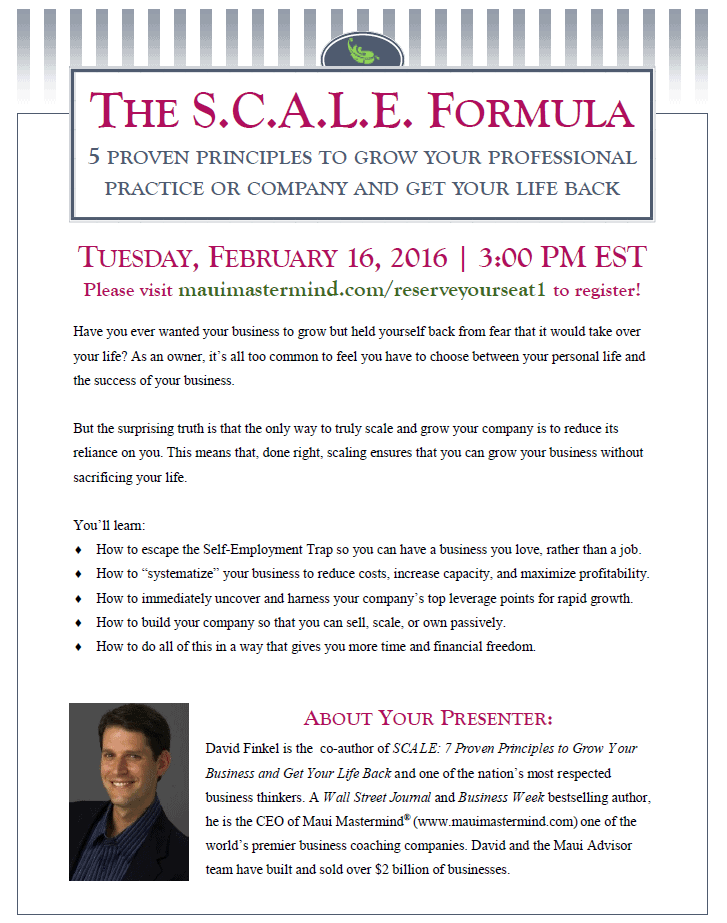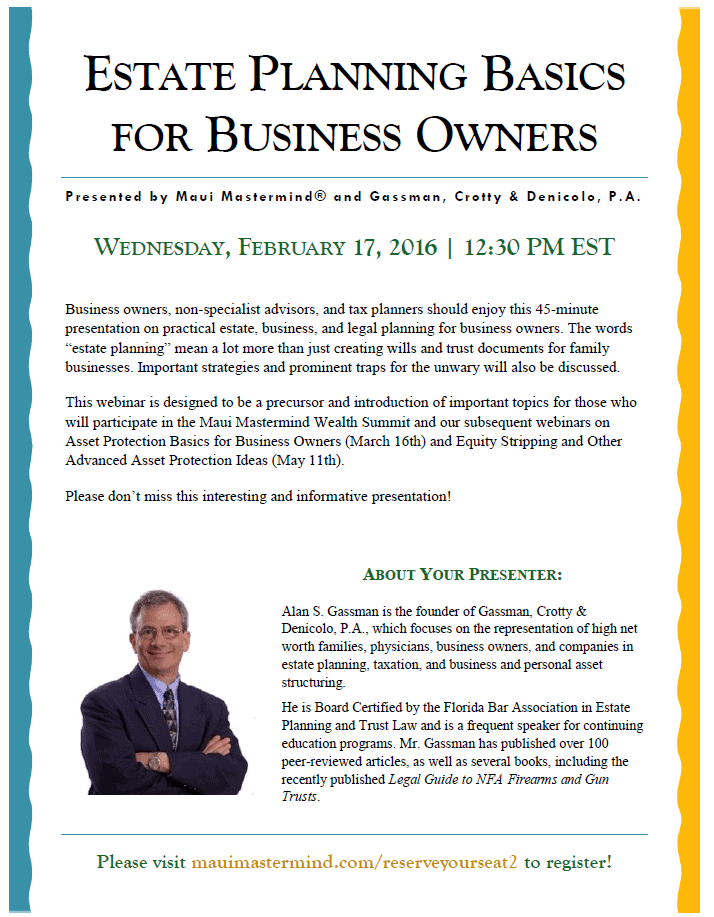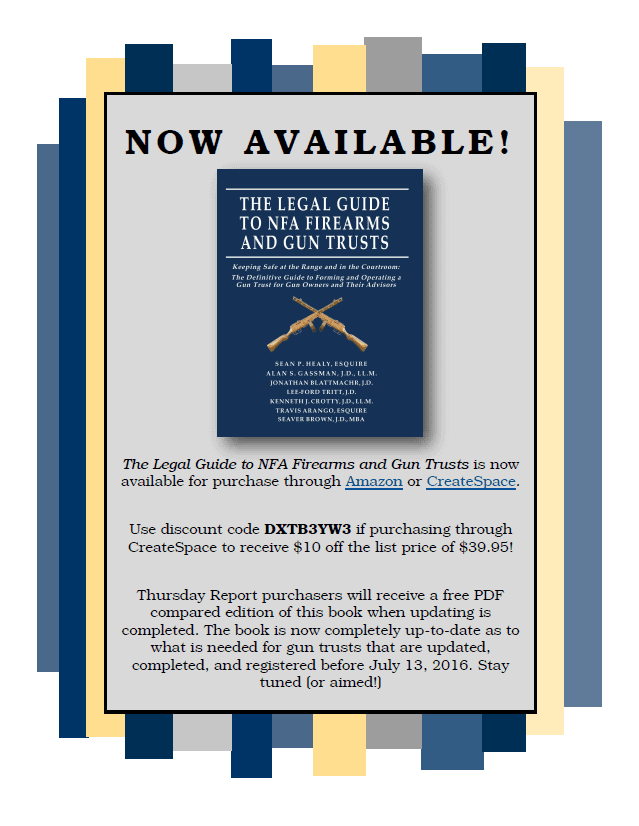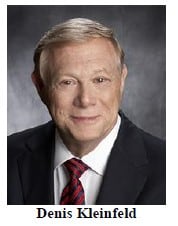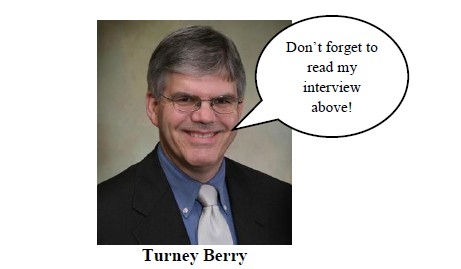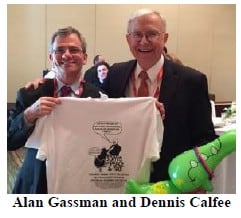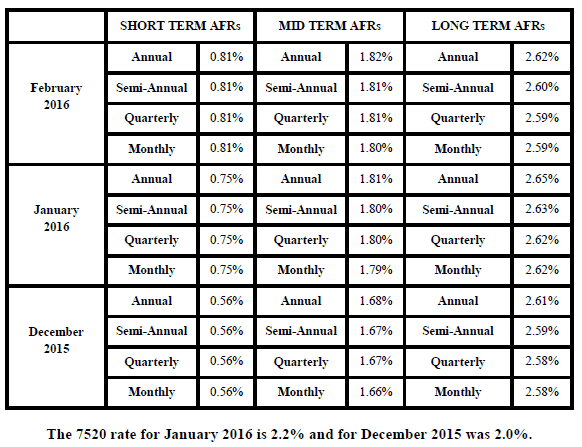The Thursday Report – 2.11.16 – Thursday Unplugged
Important Changes to Our Writings on the Ability to File an Extension to Elect Portability for a Small Estate
The Right to Die Versus a Suffering Life
An Interview with Turney Berry – Leading the Field in Charitable Planning to Reduce Income and Estate Taxes
Free Upcoming Webinars Courtesy of Maui Mastermind and Gassman, Crotty & Denicolo, P.A.
Richard Connolly’s World – Gun Silencers Sell Briskly Before New Regulation
Thoughtful Corner – How to Cultivate a Successful Attitude by Denis Kleinfeld
Humor! (or Lack Thereof!)
We welcome contributions for future Thursday Report topics. If you are interested in making a contribution as a guest writer, please email Stephanie at stephanie@gassmanpa.com.
This report and other Thursday Reports can be found on our website at www.gassmanlaw.com.
All Children’s Hospital Foundation thanks Jonathan Blattmachr, Howard Zaritsky, Lee-Ford Tritt, Lauren Detzel, and Michael Markham for an amazing one-day conference on Wednesday, February 10, 2016. This conference was attended by over 400 in 9 different locations.
Please set your calendar for February 9, 2017 for another amazing one-day conference that will include presentations by Turney Berry, Paul Lee, Sandy Schlesinger, Jerry Hesch, and Alan Gassman. Suggestions on topics and otherwise are always appreciated. Breakfast and lunch will be included, but sorry, no Kentucky Fried Chicken!
Special thanks to Lydia Bailey for being the best tax conference manager in the Western hemisphere, Australia, New Zealand, and Papua New Guinea!
Quote of the Week
“If you don’t have time to do it right, when will you have time to do it over?”
– John Wooden
John Robert Wooden was an American basketball player and coach. As the Head Coach at the University of California Los Angeles, he won ten NCAA national championships in a 12-year period, including a record-setting seven in a row. To date, no other coach or school has won the tournament more than two consecutive years. John Wooden was named the National Coach of the Year six times throughout his career and is best known for his “Pyramid of Success,” which can be viewed by clicking here.
We thank Jeff Howard of Ray Howard & Associates for sending this quote to us for inclusion in today’s Report!
Important Changes to Our Writings on the Ability to File an Extension to Elect Portability for a Small Estate
“When you make a mistake, admit it. When you’re not sure whether you’ve made a mistake or not, let others decide.”
– Colonel Harland Sanders
Our February 1, 2016 article in the Steve Leimberg LISI newsletter number 2387 had a flaw, and it was spotted by a number of well-respected commentators.
Some healthy debate has ensued, with many authorities believing that it is perfectly safe to file a Form 4768 to extend an estate tax return for a small estate so as to file a Form 706 to allow for portability to apply.
Others, including us, are not so sure. The bottom line is that the Form 4768 extension should state a specific reason for the necessity to extend.
For our revised and compared LISI newsletter, which will be re-published very soon (thanks to Steve Leimberg for his infinite patience and wisdom!), please click here.
For more on portability mistakes, Alan Gassman will be presenting a one-hour webinar with InterActive Legal on March 4th, 2016 at 1:00 PM EST. This webinar will be entitled, “Ten Common Portability Mistakes and What You Need to Know to Avoid Them.” If you are interested in registering for this webinar, please click here.
The Right to Die Versus a Suffering Life
by Alan Gassman, Lydia Greiner, and Dena Daniels
“To be, or not to be: that is the question:
Whether ‘tis nobler in the mind to suffer
The slings and arrows of outrageous fortune,
Or to take arms against a sea of troubles,
And by opposing end them? To die: to sleep;
No more; and, by a sleep to say we end
The heart-ache and the thousand natural shocks
That flesh is heir to, ‘tis a consummation
Devoutly to be wish’d. To die, to sleep;
To sleep: perchance to dream: ay, there’s the rub.”
– William Shakespeare, Hamlet
In the famous Shakespearean soliloquy delivered by Hamlet, the speaker contemplates whether he should continue to exist, whether it is nobler to suffer in an unbearable situation, or to die. The Right-to-Die movement has evolved over time in the United States and is gaining momentum as states are enacting legislation affording the right-to-die to their residents and state courts are ruling that the right-to-die is a fundamental right and eliminating criminal liability for physicians. This article will take a look into the right-to-die laws in the US and how this movement is impacting the country.
Although the first euthanasia bill was drafted in Ohio in 1906, the origin of the right-to-die movement in the US is said to have begun in 1975 when Derek Humphry, an American journalist whose wife was suffering from bone cancer, assisted his wife in taking her own life. In 1980, Humphry founded the Hemlock Society, the first right-to-die organization in the United States. The mission of the Hemlock Society was to help individuals who were suffering from terminal illnesses experience a peaceful death along with advocating for laws that provide individuals with a right-to-die. The establishment of the Hemlock Society launched the movement for assisted dying in the US.
Death with Dignity laws provide mentally competent, terminally ill individuals with the right to voluntarily request and receive a prescription medication that will allow them to die in a peaceful, humane manner, in a place and time of their choosing. Enacted in 1997, the state of Oregon has the longest standing aid-in-dying law in the US. However, several states are beginning to wander down the trail Oregon has blazed by enacting their own Death with Dignity laws.
Various forms of Death with Dignity laws have been implemented both domestically and internationally. On the international front, Switzerland has the oldest standing assisted suicide law enacted in 1940. Colombia, Albania, The Netherlands, Belgium, and Luxembourg each has its own rendition of the right-to-die law. As of today, Oregon, Washington, and Vermont are the only states that have Death with Dignity statutes. However, physician assisted death is permitted in four (4) states: the aforementioned states and Montana, whose Supreme Court eliminated criminal liability for physician-assisted suicide. There is also current litigation regarding the right-to-die in New Mexico and pending legislation in California. Most states that have enacted a “right to die” statute model their respective Acts after Oregon’s Death with Dignity Act.
Eligibility Under Implemented Death with Dignity Acts
To qualify for prescription of medication under Death with Dignity laws, you must be:
- A resident of Oregon, Washington, or Vermont;
- 18 years of age or older;
- Mentally competent;
- Diagnosed with a terminal illness that will, within reasonable medical judgment, lead to death within six (6) months.
The individual must also be able to self-administer and ingest the prescribed medication. Two (2) physicians are required to determine whether all of the aforementioned criteria has been met.
Residency
As residency is a requirement under the Death with Dignity laws, it may be established by providing:
- A state issued identification card or driver’s license; or
- Documents showing that you own or rent property in the state; or
- A state voter registration; or
- A recent state tax return.
There is no minimum length-of-residency requirement.
The Status of the States: Places that May Soon Recognize the Right-to-Die
Montana
On December 31, 2009, the Montana State Supreme Court ruled in Baxter v. Montana that under the privacy and dignity provisions of the Montana Constitution, a right to die with dignity exists, including the right to a physician’s assistance in dying. Baxter v. Montana, 354 Mont. 234 (2009). In Baxter, the plaintiff, Robert Baxter was suffering from lymphocytic leukemia and desired to end his life by ingesting a prescription that would be prescribed by his doctor. In an effort to insulate the doctor from criminal prosecution for providing the necessary assistance with the suicide, the physician joined Baxter in the suit against the State of Montana. The Court held that the prescribing physician would be protected from criminal prosecution as a result of the statutory defense of consent to a homicide under Montana law. §45-2-211(1), MCA.
The Montana Supreme Court concluded that:
…we find nothing in Montana Supreme Court precedent or Montana statutes indicating that physician aid in dying is against public policy. The “against public policy” exception to consent has been interpreted by this Court as applicable to violent breaches of the public peace. Physician aid in dying does not satisfy that definition…In physician aid in dying, the patient – not the physician – commits the final death-causing act by self-administering a lethal dose of medicine.
Furthermore, the Montana Rights of the Terminally Ill Act indicate legislative respect for a patient’s autonomous right to decide if and how he will receive medical treatment at the end of his life. The Terminally Ill Act explicitly shields physicians from liability for acting in accordance with a patient’s end-of-life wishes, even if the physician must actively pull the plug on a patient’s ventilator or withhold treatment that will keep him alive. There is no statutory indication that lesser end-of-life physician involvement, in which the patient himself commits the final act, is against public policy. We therefore hold that under §45-2-211, MCA, a terminally ill patient’s consent to physician aid in dying constitutes a statutory defense to a charge of homicide against the aiding physician when no other consent exceptions apply. Id.
New Mexico
On January 13, 2014, a state court in New Mexico ruled in Morris v. Bradenburg that dying was a fundamental right under the state’s constitution and physicians who assist by prescribing the medication to a mentally competent, terminally ill patient could not be prosecuted for doing their actions. Morris v. Bradenburg, 2015-NMCA-100 (2015). The Court of Appeals overturned the state court’s ruling on August 11, 2015, providing:
A New Mexico statute makes “assisting suicide” a fourth degree felony and defines the proscribed conduct as “deliberately aiding another in the taking of his own life.” NMSA 1978, §30-2-4 (1963). The question presented is whether this statute may constitutionally be applied to criminalize a willing physician’s act of providing a lethal dose of a prescribed medication at the request of a mentally competent, terminally ill patient who wishes a peaceful end of life (aid in dying) as an alternative to one potentially marked by suffering, pain, and/or the loss of autonomy and dignity. The district court concluded that Section 30-2-4 is invalid under two provisions of the New Mexico Constitution as applied to any physician who provides aid in dying to a patient. In reaching its conclusion, the district court determined that aid in dying is a fundamental liberty interest and that the State did not meet its burden to prove that Section 30-2-4 met a strict scrutiny standard of review. We conclude that aid in dying is not a fundamental liberty interest under the New Mexico Constitution. Accordingly, we reverse the district court’s order, permanently enjoining the State from enforcing Section 30-2-4. Id.
The Court of Appeals ruling was appealed to the New Mexico Supreme Court and oral arguments were heard on October 26, 2015. The State Supreme Court is scheduled to issue a ruling some time in 2016.
California
California’s governor signed the California End of Life Option Act into law on October 5, 2015. California End of Life Option Act, ABX2-15. The law is scheduled to go into effect between January 2016 and November 2016. The California Legislative Counsel’s Digest provides that:
Existing law authorizes an adult to give an individual health care instruction and to appoint an attorney to make health care decisions for that individual in the event of his or her incapacity pursuant to a power of attorney for health care.
This bill, until January 1, 2026, would enact the End of Life Option Act authorizing an adult who meets certain qualifications and who has been determined by his or her attending physician to be suffering from a terminal disease, as defined, to make a request for a drug prescribed pursuant to these provisions for the purpose of ending his or her life. The bill would established the procedures for making these requests. The bill would also establish specified forms to request an aid-in-dying drug, under specified circumstances, an interpreter declaration to be signed subject to penalty of perjury, thereby creating a crime and imposing a state-mandated local program and a final attestation for an aid-in-dying drug. This bill would require specified information to be documented in the individual’s medical record, including, among other things, all oral and written requests for an aid-in-dying drug. Id.
As time progresses, this issue will become more prevalent in today’s society. The most recent call for public attention to the cause was led by the late Brittany Maynard through her advocacy for the right-to-die movement. In the future, more states will take a closer look at end-of-life choices for their residents and begin to present legislation that will provide individuals with a right to die with dignity.
An Interview with Turney Berry
Leading the Field in Charitable Planning to Reduce Income and Estate Taxes
Alyssa Eberle of Gassman, Crotty & Denicolo, P.A. interviewed Turney Berry, who will be speaking on a free webinar for Bloomberg BNA’s Essential Elements series entitled “Charitable Planning Techniques that Allow Uncle Sam to Contribute to Your Family and Charities.” This webinar will take place on Thursday, February 18, 2016 at 12:30 PM EST and will be moderated by Alan Gassman. Video replays will not be available.
We wanted to ask him some brief questions so that our audience got to know him and began to understand his thoughts behind his webinar topic. The following questions were asked of Mr. Berry:
Alyssa Eberle: Mr. Berry, please tell us a little bit about yourself and what you do.
Turney Berry: For 29 years, I’ve done estate and charitable planning. I got involved in the charitable side because a couple months before I started practicing law in 1986, a woman died who had been doing charitable planning for the firm that I was working for. When I became a young lawyer, they said, “Here, you take over this part of the practice,” with supervision and such, of course, but that was okay. So I’ve just been doing it ever since. Maybe a third of my practice is charitable planning, representing some charitable organizations, estate planning, some estate administration, business planning, and that sort of thing. It’s a good mix; they’re complimentary practices, it seems to me.
AE: What do you hope to achieve by participating in this webinar?
TB: My belief is that there are lots of interesting ways to link up charity with estate planning objectives. Obviously, if people haven’t had any charitable intent, then the charitable gift is really not something that turns out to be very helpful for them in most instances, but lots of people do have some kind of charitable intent, so what you can do is enable them to fulfill that charitable intent or start working on what they want to do for charity as part of their normal estate planning. Then it works out, and it’s a win-win all around.
AE: Can you give us an example of the application of charitable intent in estate planning practices?
TB: We have, at least in this part of the country, a lot of what I think of as “ancestral homes.” We sort of jokingly describe an ancestral home as a home where the parents or grandparents really hope the kids want to keep and move into the home, and, of course, the kids want absolutely nothing to do with it, but it’s an ancestral home, or it’s a historic farm that’s been in the family for years and years, and the question is: how do you keep that in the family? Well, if the folks have charitable intent of some sort, then a way to think about that is to do one of my favorite things: give a remainder interest in the house or farm to charity.
So if I’ve got this big, old house that’s been in the family a long time or a farm that I’d like to keep in the family, I say that after my wife and I die, whatever particular charity is going to get that interest – maybe it’s to my favorite charity, the opera, the orchestra, whatever it might be – I give them a remainder interest. The IRS has actuarial tables so we can figure out what the government guesses the property is going to be worth based on what it’s worth today and how long my wife and I are going to live, and I get an income tax deduction for that. Now, this works out pretty well because I still own the property. I live on the property. If I want to paint it purple, I’ll paint it purple. It’s just that after I die, I’ve said it’s going to go to charity.
AE: What happens if you have a client who would like to keep the property in the family?
TB: If, in fact, we want to keep the property in the family, then after some period of time, usually three or four years, my children or grandchildren, or the trust for the children and grandchildren, can go to the charity and buy that remainder interest. So, at my death, the property goes to the charity so my estate gets an estate tax deduction. I’ve gotten an income tax deduction since I’ve promised to leave it to charity, and then, at my death, my estate gets an estate tax deduction, but the charity has essentially promised to convey the property over to my children or grandchildren or a trust because they have paid. So it’s all a win-win.
The charity gets its money up front, and I get an income tax deduction up front, and the children and grandchildren know that by paying some money up front, they’re going to get this property without there being any additional estate tax, so it’s, in my judgment, a pretty good sort of deal. Terrible deal, if you don’t have any charitable intent, but if people do have charitable intent, it works like a charm. A lot of people know it’s possible, but they’ve never heard anyone talk about interesting ways to do it or use it as such, so that’s what I’m trying to do with this webinar.
AE: When you encourage or introduce people to these types of techniques, if they do have charitable intent, what advice would you give to someone who is considering doing something like what you just mentioned?
TB: What you’re trying to do is match up the assets and the intent that they have with estate planning ideas that you know work. If they have a property in the way I described, you would talk about that technique. Maybe they have a big portfolio of multiple shares, and you know they give $100,000 to charity every year that comes out of their interest in dividends that they earn off of their securities. Then you might talk with them about a charitable lead trust. You’re just trying to match what the folks are doing and what they want to do with what their assets are and give them some ideas about how to improve their plans from a tax and administration perspective.
AE: Could you provide a brief introduction into the differences between private and public foundations and how they work in charitable planning?
TB: Sure. The private foundation is essentially a charitable organization that I create or that my family and I create, and, because a few people create and manage it, since 1969, the government has worried that it’s not subject to very much control because it’s really sort of private. There are all kinds of restrictions about what can be done. Donors can’t have much interaction with private foundations; they can’t buy and sell stuff or co-own property with a private foundation. There are all sorts of rules that come into play.
If you take a whole bunch of funds that are created by individuals, that would be private foundations because they’re all separate, but you stick them all together, and you have an independent board that has to approve everything that the private people want to do, then we call that a community foundation. Community foundations typically have these things called donor advised funds, which, if it were standing alone, would be a private foundation, but because it’s really governed by the independent board of this charity, then it gets treated like a public charity. There are some exceptions to that, but for the most part, the government lets you out of most of the private foundation restrictions.
AE: Are there any other types of charitable foundations that could potentially serve a purpose in estate planning?
TB: You also have pure, simple public charities, and those are things that are funded by lots of different people. If I have just a few funders, then I’ve got a private foundation. If I’ve stuck private foundations together, I’ve got a community foundation, but if I have lots and lots of different funders, I’ve got something like a university or the Red Cross or an organization like that, and the government says, “Well, because there are so many different donors, nobody private is getting any benefit out of this, and the general need to raise money from different organizations means that you have to have a good reputation in the community, and for that reason, we’re not going to impose very many particular restrictions on these sorts of organizations.” There are some restrictions – you can’t benefit private people, and you can’t pay people too much – but otherwise, you’re regulation free, which is a pretty good deal.
AE: What are some of the biggest mistakes that you see estate planning lawyers make when including charitable planning as part of their client’s estate plan?
TB: That’s an interesting question. A lot of estate planners don’t do enough charitable planning to have a very sophisticated understanding of how these things actually work, so they know about a technique, but they haven’t necessarily run the math on the different ways something can be funded or exactly how to structure a particular charitable technique. For example, doing a charitable lead trust is just like doing a GRAT, and with GRATs, you structure them in different ways depending on the assets that you have, etc. Well, how many people give that same degree of thought when doing a charitable lead annuity trust? How many people run illustrations?
So I think there are two things. (1) Some people don’t know much about charity, and they’re nervous about it, so they don’t talk to their clients about it. They just try to avoid it and hope it doesn’t come up, and (2) You have other folks where it does come up, and they just put in the first thing that’s simple that comes to their mind, as opposed to really giving it the full thought that they would to a regular estate plan. Thus, the client doesn’t get as good of a result as they would have otherwise.
AE: What are the biggest opportunities that you see for estate planners to obtain their client’s charitable objectives?
TB: I think what you’re trying to do is just match up. If a client is trying to create a fund to allow the teaching of ancient history, the question is: where do they put the money? How do they get the money there? Do they just leave a bequest? Do they leave the money from their retirement plan? Do they leave a business and have a business redeem the stock? What’s the most efficient way to do it?
That varies client by client, but there are certainly better and worse ways in every instance to do that, and so it’s really not much different than any other estate planning. You’re trying to come up with the most effective and efficient way to accomplish objectives given the tax laws, what the client’s assets are, and what the client’s goals are.
AE: In terms of pitfalls or dangers that planners need to watch out for when it comes to some of these techniques, is there are any dangerous technique that should be avoided?
TB: I guess a warning sign is when somebody says that I’ve got a charitable need where your client can leave money to charity, and their heirs will get the same amount they were going to get anyway. The odds are there’s something wrong there, because the system is not really set up for that. The system is set up to make it efficient for you to make charitable gifts, so that if you give a million dollars to charity, it shouldn’t cost your heirs a million dollars, but on the other hand, your heirs shouldn’t be in the exact same spot they were going to be in if you had done nothing, so I tell folks that if you’ve got an idea, and it looks to be neutral with respect to your heirs, there’s probably a problem with that notion, so you just have to be careful with that.
AE: Well, thank you, Mr. Berry! It was a pleasure.
To register for this FREE Bloomberg BNA “Charitable Planning Techniques that Allow Uncle Sam to Contribute to Your Family and Charities” webinar, please click here.
Free Upcoming Webinars Courtesy of Maui Mastermind
and Gassman, Crotty & Denicolo, P.A.
PLEASE CLICK HERE TO REGISTER FOR THE S.C.A.L.E. FORMULA
PLEASE CLICK HERE TO REGISTER FOR
ESTATE PLANNING BASICS FOR BUSINESS OWNERS
Richard Connolly’s World
Gun Silencers Sell Briskly Before New Regulation
Insurance advisor Richard Connolly of Ward & Connolly in Columbus, Ohio often shares with us pertinent articles found in well-known publications such as The Wall Street Journal, Barron’s, and The New York Times. Each week, we will feature some of Richard’s recommendations with links to the articles.
This week, the article of interest is “Gun Silencers Sell Briskly Before New Regulation” by Ashby Jones. This article was featured in The Wall Street Journal on January 28, 2016.
Richard’s description is as follows:
The National Firearms Act of 1934, the Depression-era law governing silencers and a small group of other federally regulated firearms, requires that people who want to buy a silencer first get approval from a local law-enforcement agent.
To sidestep such approval, many buyers have used a loophole for the past decade, according to gun experts, by setting up legal entities called trusts, which don’t require law enforcement sign-off.
Trusts offer other advantages over silencer registrations by individuals. A silencer registered to an individual may be used only by that person. Letting someone else borrow or store the silencer isn’t allowed. Trusts allow a group of people to share access to guns and accessories and freely exchange them among themselves.
The Bureau of Alcohol, Tobacco, Firearms & Explosives said 111,599 trusts for silencers and other firearms covered under the 1934 law were set up in 2014, the latest data set available. The figure was up sharply from the 13, 710 trusts approved in 2009.
The vast majority of silencer purchases in recent years have been made by trusts. For instance, Mr. Rose of Sterling Arsenal said that all but three of the roughly 2,000 of his customers in 2015 used trusts to buy silencers.
“People are staring down significantly more hurdles on setting up a trust, so they’re racing to beat the deadline.”
Please click here to read this article in its entirety.
Please click here to purchase the book on Amazon.
Please click here to purchase the book on CreateSpace.
Thoughtful Corner
How to Cultivate a Successful Attitude
by Denis Kleinfeld
Denis Kleinfeld practices law as Of Counsel to Fuerst Ittleman David & Joseph, PL, in Miami, Florida. He has a B.S. degree in Accountancy from the University of Illinois and a J.D. from the Loyola University of Chicago School of Law. He is a member of the Illinois Bar, the Florida Bar, the American Bar Association, the Florida Institute of Certified Public Accountants, and the American Institute of Certified Public Accountants. Mr. Kleinfeld is highly regarded as a lawyer, teacher, and author and is known for his ability to analyze complex issues, develop pragmatic legal solutions, and creatively resolve controversies for businesses and individuals. He advises US and international companies, businesspersons, investors, professionals, families, and individuals. He can be reached at deniskleinfeld@kleinfeld.com.
When I was studying for my CPA exam at the University of Illinois, my teacher in the CPA review course said to me that based on my performance to date, I was unlikely to pass. He suggested I drop the review course altogether and just take it the following year, when I would be better prepared. Viscerally, I knew he was right.
That is, right at the moment.
I realized that I had a choice to make. Either follow his advice and drop the CPA review course or do something different than I was doing up to that time.
Instead of taking his advice and the easy way out, I charted a different course. My decision was to study smarter and harder. I set a fixed schedule of intense review from 6 AM to midnight every day. In addition to the review course materials, I planned on re-doing every problem of every single accounting course I had ever taken. If I hadn’t learned accounting the first time around, I was going to learn it this time.
Fortunately, it turned out to be a successful effort. I first passed the review course, then I passed the exam. I became a CPA in Illinois.
This story illustrates what I learned are some of the keys to creating a successful mindset when faced with a life’s challenge.
Attitude: I have always had the attitude that I will be successful. It is not a matter of just saying, “I can’t fail,” that helps me to exert my absolute full effort. It’s about knowing that, deep down, I have the ability to do what it takes to succeed. To be successful means I must first believe in myself. Failure is always a possibility, but if I do fail, it will not be for lack of belief that my success is possible.
Acceptance: When my teacher told me I was going to fail the exam, I had to take a long, hard look at myself. In doing so, I understood that he was right. I was deficient. If I had to take the exam that day, I would have failed it. I was able to accept myself exactly where I was. I accepted that I was just not prepared.
Action: It’s important to believe in yourself and your ability to face challenges. It’s also vital you accept where you are so that you understand exactly what needs to happen next. Finally, however, you must do something about it. Making the effort is the step many overlook; we think the power of positive thought will attract good things to us without us having to do more. In this case, my action was to study for hours every day and to review my entire education until I had grasped the material firmly.
Achieving success is a mindset. It starts with believing you can achieve your goals. Then, you must take a deep and critical look at yourself to find out where you are at the moment. Then, you must articulate what the goal is. That is, when you achieve success, what will it look and feel like when you get there? When you understand the beginning and the end, then you can determine what you need to do to make success happen.
Success is not about changing yourself; it is about accepting yourself but changing your patterns and routines. Creating the habits of success provides a success mindset and the tools necessary to make reaching a goal a reality. Achieving success is a process that can be replicated time after time.
Next time you are faced with a difficult challenge, try the Attitude/Acceptance/Action process. Good action is always more successful than a good excuse.
Humor! (or Lack Thereof!)
Sign Saying of the Week
***************************************************
IN THE NEWS
by Ron Ross
Congress offers a new BOGO deal: Buy one Congressman, get another one free.
************
More gridlock in Washington, DC: Obama won’t take down his
Christmas lights until Congress takes down theirs.
***************************************************
THE INQUISITIVE FIVE YEAR OLD
by Ron Ross
Daddy, why is the sky blue?
Why is there no hair on top of you?
Where does the light go when you close the fridge door?
Why do they chase sister when she runs from the store?
Why does brother say I was left by Gypsies?
What does Mom mean when she says she’s tipsy?
Why do you always take that blue pill?
Why did Grandpa leave you out of his will?
Is blue the only thing visible after air molecules’ refraction?
Can LLC avoid probate and trust interaction?
What does it mean when they say I have ADD?
When you get my adoption tax credit will you share it with me?
Upcoming Seminars and Webinars
Calendar of Events
LIVE COMPLIMENTARY WEBINAR:
Wall Street Journal and Business Week bestselling author David Finkel will present a free, one-hour webinar on the topic of THE SCALE FORMULA: 5 PROVEN PRINCIPLES TO GROW YOUR BUSINESS OR PROFESSIONAL PRACTICE AND GET YOUR LIFE BACK.
Date: Tuesday, February 16, 2016 | 3:00 PM – 4:00 PM
Location: Online webinar
Additional Information: To register for this presentation, please click here. For more information, please contact Alan Gassman at agassman@gassmanpa.com.
**********************************************************
LIVE COMPLIMENTARY MAUI MASTERMIND WEBINAR:
Alan Gassman will present a free, 45-minute webinar on the topic of ESTATE PLANNING BASICS FOR BUSINESS OWNERS.
This webinar will be specially made for and presented in partnership with Maui Mastermind. Clients, advisors, and colleagues of Gassman, Crotty & Denicolo are welcome to attend.
Date: Wednesday, February 17, 2016 | 12:30 PM – 1:30 PM
Location: Online webinar
Additional Information: To register for this presentation, please click here. For more information, please contact Alan Gassman at agassman@gassmanpa.com.
**********************************************************
LIVE WEBINAR:
Alan Gassman will moderate a free Bloomberg BNA Essential Elements webinar with special guest Turney Berry on the topic of CHARITABLE PLANNING TECHNIQUES THAT ALLOW UNCLE SAM TO CONTRIBUTE TO YOUR FAMILY AND CHARITIES.
Date: February 18, 2016 | 12:30 PM
Location: Online webinar
Additional Information: To register for this webinar, please click here. For more information, please email Alan Gassman at agassman@gassmanpa.com.
**********************************************************
LIVE WEBINAR:
Alan Gassman will moderate a Bloomberg BNA Practical & Creative Planning webinar with special guest Jonathan Blattmachr on the topic of FUNDAMENTALS, FINE POINTS, AND INNOVATIVE STRATEGIES FOR LIFE INSURANCE AND USE THEREOF.
Bloomberg BNA will charge for this webinar and this series of webinars, but we believe it is well worth it! We will have the full schedule available in a future Thursday Report.
Date: February 25, 2016
Location: Online webinar
Additional Information: To register for this webinar, please click here. For more information, please email Alan Gassman at agassman@gassmanpa.com.
**********************************************************
LIVE COMPLIMENTARY MAUI MASTERMIND WEBINAR:
Wall Street Journal and Business Week bestselling author David Finkel will present a free, one-hour webinar on the topic of THE SIX-STEP TIME VALUE MATRIX TO RECLAIM 4-8 HOURS A WEEK TO INVEST IN GROWING YOUR BUSINESS.
Date: Thursday, March 3, 2016 | 12:00 PM – 1:00 PM
Location: Online webinar
Additional Information: To register for this presentation, please click here. For more information, please contact Alan Gassman at agassman@gassmanpa.com.
**********************************************************
LIVE INTERACTIVE LEGAL WEBINAR:
Alan Gassman will present a live, one-hour webinar on the topic of TEN COMMON PORTABILITY MISTAKES AND WHAT YOU NEED TO KNOW TO AVOID THEM.
This webinar is part of InterActive Legal’s Hot Topic Webinars series.
Date: Friday, March 4, 2016 | 1:00 PM EST
Location: Online webinar
Additional Information: To register for this webinar, please click here. For more information, please email Alan Gassman at agassman@gassmanpa.com.
**********************************************************
LIVE COMPLIMENTARY MAUI MASTERMIND WEBINAR:
Alan Gassman will present a free, 45-minute webinar on the topic of ASSET PROTECTION BASICS FOR BUSINESS OWNERS.
This webinar will be specially made for and presented in partnership with Maui Mastermind. Clients, advisors, and colleagues of Gassman, Crotty & Denicolo are welcome to attend.
Date: Wednesday, March 16, 2016 | 12:30 PM – 1:30 PM
Location: Online webinar
Additional Information: To register for this presentation, please click here. For more information, please contact Alan Gassman at agassman@gassmanpa.com.
**********************************************************
LIVE UNIVERSITY OF FLORIDA PRESENTATION:
Saturday, March 19 (or Saturday, April 2nd – date to be determined!), Alan Gassman will be speaking to Professor Dennis Calfee’s University of Florida Tax LL.M. program on PROFESSIONAL ACCELERATION FOR ESTATE PLANNING LAWYERS.
Alan’s six-hour, interactive workshop sessions will include breakout discussions on goals, time management, enjoyment of what we do, and time-tested tools and techniques for making the best of the opportunity to help others and our communities in a fascinating profession.
We welcome your input, and, if you know any UF law students who would like to attend, please email agassman@gassmanpa.com.
Date: Saturday, March 19, 2016 OR Saturday, April 2, 2016 | 9:00 AM – 3:00 PM
Location: University of Florida | Gainesville, FL
Additional Information: For more information, please email Alan Gassman at agassman@gassmanpa.com.
**********************************************************
LIVE MIAMI PRESENTATION:
FLORIDA BAR WEALTH PROTECTION CONFERENCE
The Annual Florida Bar Wealth Protection Conference in Miami on Thursday, April 14th and Friday, April 15th will definitely be our best program ever! You can attend one or both days.
Speakers will include Barry Engle, Howard Fisher, Denis Kleinfeld, Jonathan Gopman, Alan Gassman, and many others! The two-book course materials will be available to all attendees.
A Thursday evening dinner with the speakers and a post-dinner small group discussion and workshop on Practice Acceleration will be available only to those who attend the live sessions.
Our tentative program, which will be subject to changes in the next week or two, can be viewed by clicking here.
Date: Thursday, April 14th, 2016 and Friday, April 15th, 2016
Location: Hyatt Regency Miami | 400 SE 2nd Avenue, Miami, FL 33131
Additional Information: For more information, please email Alan Gassman at agassman@gassmanpa.com.
**********************************************************
LIVE COMPLIMENTARY MAUI MASTERMIND WEBINAR:
Wall Street Journal and Business Week bestselling author David Finkel will present a free, one-hour webinar on the topic of MORE WITH LESS: 5 SIMPLE STEPS TO ENJOY MORE BUSINESS GROWTH AND GREATER PERSONAL FREEDOM BY DOING LESS.
Date: Thursday, April 28, 2016 | 12:00 PM – 1:00 PM
Location: Online webinar
Additional Information: To register for this presentation, please click here. For more information, please contact Alan Gassman at agassman@gassmanpa.com.
**********************************************************
LIVE NAPLES PRESENTATION:
3RD ANNUAL AVE MARIA SCHOOL OF LAW ESTATE PLANNING CONFERENCE
This one-day conference will take place in Naples, Florida on Friday, May 6, 2016.
On Thursday, May 5, there will be a special dinner with Jonathan Blattmachr. Jonathan will also present at the conference on Friday. Be sure to bring an extra pair of socks because the first pair will get knocked off by Jonathan’s talk!
Alan’s Friday morning presentation will be entitled COFFEE WITH ALAN: AN INTRODUCTION TO SELECT ESTATE PLANNING AND ASSET PROTECTION STRATEGIES. During this session, Alan will offer an overview of the topics that will be presented throughout the Estate Planning Conference. Attendees new to these specific estate planning areas will find the presentation useful and helpful.
Alan will also moderate the Luncheon Speaker Panel with Jonathan Blattmachr, Stacy Eastland, and Lee-ford Tritt. The panel will cover the topic of WHAT WE WISH WE KNEW WHEN WE STARTED PRACTICING LAW – NON-TAX AND PRACTICAL ADVICE FOR ESTATE PLANNERS YOUNG AND OLD.
Date: May 6, 2016
Location: Ritz Carlton Golf Resort | 2600 Tiburon Drive, Naples, FL, 34109
Additional Information: For more information, please contact Alan Gassman at agassman@gassmanpa.com.
**********************************************************
LIVE COMPLIMENTARY MAUI MASTERMIND WEBINAR:
Alan Gassman will present a free, 45-minute webinar on the topic of EQUITY STRIPPING AND OTHER ADVANCED ASSET PROTECTION IDEAS.
This webinar will be specially made for and presented in partnership with Maui Mastermind. Clients, advisors, and colleagues of Gassman, Crotty & Denicolo are welcome to attend.
Date: Wednesday, May 11, 2016 | 12:30 PM
Location: Online webinar
Additional Information: To register for this presentation, please click here. For more information, please contact Alan Gassman at agassman@gassmanpa.com.
**********************************************************
LIVE TAMPA PRESENTATION:
MAUI MASTERMIND ACCREDITED INVESTOR WEALTH WORKSHOP
Maui Mastermind will present their three-day ACCREDITED INVESTOR WEALTH WORKSHOP on July 21st – 23rd.
The first two days of this event will feature three speakers: David Finkel, Kevin Bassett, and Alan Gassman, on a variety of topics including advanced asset protection topics, reducing your tax drag, creating more with less, and how to create and sustain rapid growth of your business or company.
Saturday, July 23rd will feature a bonus add-on to the program entitled SCALE YOUR MEDICAL PRACTICE: PROVEN STRATEGIES TO GROW YOUR PRACTICE, INCREASE YOUR CASH FLOW, AND CREATE MORE PERSONAL FREEDOM. This event will feature David Finkel’s presentation on scaling a medical practice.
Watch this space as more details will be forthcoming!
Date: Thursday, July 21st – Saturday, July 23rd
Location: Tampa Marriott Westshore | 1001 N. Westshore Blvd., Tampa, FL, 33607
Additional Information: For more information, please email Alan Gassman at agassman@gassmanpa.com.
Notable Events by Others
LIVE TAMPA PRESENTATION:
2016 FLORIDA TAX INSTITUTE
The 2016 Florida Tax Institute, organized by the University of Florida Levin College of Law, will feature top speakers in the United States on tax, business, and estate planning issue. This program is designed to be informative, engaging, and state of the art!
For a full conference agenda, please click here. Up to 24 hours of continuing education legal credit will be available in several states, while Accounting, Certified Financial Planner, Certified Trusts and Financial Advisor, and Enrolled Agents PACE credit will be available nationwide.
Date: Wednesday, March 30, 2016 – Friday, April 1, 2016
Location: Tampa Marriott Waterside | 700 S. Florida Avenue, Tampa, FL 33602
Additional Information: To register for this event, please click here. For more information, please email admin@floridataxinstitute.org.
Applicable Federal Rates
Below we have this month, last month’s, and the preceding month’s Applicable Federal Rates, because for a sale you can use the lowest of the 3.

